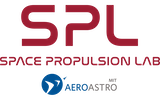Two primary propulsion modes currently exist for spacecraft: chemical (e.g. monopropellant, cold gas, solid propellant) and electric (e.g. Hall thruster, ion engine, electrospray). Chemical propulsion typically offers high thrust and low specific impulse, while electric propulsion provides the inverse of low thrust and high specific impulse. As such, having access to both modes on the same spacecraft is extremely useful for a wide range of applications. A high-performance exploration mission, like NASA’s Dawn mission, is an example of a spacecraft hosting chemical and electric thrusters, without which the mission could not have been possible.
The conventional propellants used by chemical and electric thrusters are highly incompatible, making this particularly difficult for small spacecraft, which lack the mass, power, and volume to accommodate two separate propulsion systems. However, recent advancements in green monopropellants - developed as less-toxic alternatives to hydrazine in chemical monopropellant thrusters - have created a new family of propellants that are also compatible with electric thrusters. In particular, hydroxylammonium nitrate (HAN) based green monopropellants are also ionic liquids, which is the standard propellant for electrospray thrusters. A prominent example of a HAN-based monopropellant is ASCENT (formerly AF-M315E), which was first synthesized by the US Air Force and successfully demonstrated on NASA’s Green Propellant Infusion Mission (GPIM) in 2019.
These propellants enable a unique opportunity: a multimodal propulsion system with chemical monopropellant thruster(s) and electrospray thruster(s) that are fed from a shared green monopropellant tank. The objective of this research is to enable a direct application of this technology by investigating the performance of green monopropellants in electrospray thrusters and integrating these thrusters into a flight-ready propulsion system. Our aim is to investigate the use of green monopropellants (specifically, energetic ionic liquids such as ASCENT) in electrospray thrusters, and to then design and characterize a bimodal chemical-electrospray thruster system that combines chemical and electric propulsion into a shared system with common propellant.

Figure 1: Schematic of a proposed bimodal chemical-electrospray propulsion system [2].
Electrospray Thruster Performance
Recent research efforts focus on characterizing the performance of electrospray thrusters with energetic ionic liquids. In particular, these characterizations focus on propulsive performance (thrust and specific impulse) as well as other operating metrics (current-voltage relationship, thruster efficiency, plume angle). This work is ongoing with collaborations with NASA Marshall Space Flight Center (MSFC) and the Air Force Research Laboratory (AFRL) to better understand how ASCENT and other energetic ILs can be used in electrospray thrusters.

Figure 2: Current-voltage relationship for electrospray thruster firing conventional propellant (EMI-BF4) and monopropellants (ASCENT and GEM) [3].
Table 1: Experimental performance values for electrospray thruster firing conventional propellant (EMI-BF4) [3].

Table 2: Experimental performance values for electrospray thruster firing energetic ionic liquid monopropellant (ASCENT) [3].

Additionally, current research efforts include investigating long-term performance of electrospray thrusters fueled by ASCENT. This work includes modifying the MIT SPL electrospray thrusters to be refillable from a central tank to enable a bimodal chemical-electrospray system. Key areas include propulsive performance over time, mass loss anomalies, and failure mechanisms at several hundred hours of thruster operations.
Satellite Engineering
MIT SPL is part of a collaboration with NASA Marshall Space Flight Center, Georgia Institute of Technology’s Space Systems Design Lab, Plasma Processes LLC, and Espace Inc to develop a technology demonstration mission of bimodal chemical-electrospray propulsion. Support for this mission is ongoing and includes propellant management, high voltage and current management, plume effects, and satellite integration testing.
Relevant Publications
[1] A. Bruno, "Design of a Bimodal Chemical-Electrospray Propulsion System using Ionic Liquid Monopropellants," Master's thesis, Massachusetts Institute of Technology, Cambridge, MA, 2021
[2] A. Bruno and P. Lozano, "Design and Testing of a Propellant Management System for Bimodal Chemical-Electrospray Propulsion," Proceedings of the 42nd IEEE Aerospace Conference, Virtual 2021
[3] A. Bruno, M. Schroeder, and P. Lozano, "Characterization of Electrospray Thrusters with HAN-Based Monopropellants for Multimode Propulsion Applications," 2022 AIAA SciTech Forum, San Diego, CA, 2022.
[4] B. Colón et al. "Spectre: Design of a Dual–Mode Green Monopropellant Propulsion System," Rocky Mountain American Astronautical Society GN&C Conference, Breckenridge, CO, 2022.
